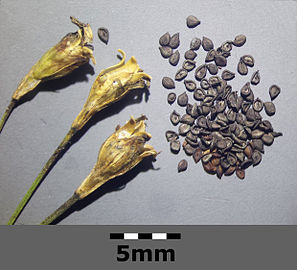Petrorhagia saxifraga
| Petrorhagia saxifraga | |
|---|---|

| |
| Scientific classification | |
| Kingdom: | Plantae |
| Clade: | Tracheophytes |
| Clade: | Angiosperms |
| Clade: | Eudicots |
| Order: | Caryophyllales |
| Family: | Caryophyllaceae |
| Genus: | Petrorhagia |
| Species: | P. saxifraga
|
| Binomial name | |
| Petrorhagia saxifraga | |
| Synonyms[1] | |
|
List
| |
Petrorhagia saxifraga, known as tunic flower or coat flower, is a small, herbaceous flowering plant in the family Caryophyllaceae.[1][2] It is native to parts of Europe and introduced to the United States and Canada, Great Britain, and Sweden.[1][2] Petrorhagia saxifraga is also known as tunic saxifrage, pink saxifrage, or just pink.[3][4]
It is a wiry plant with numerous branching stems, narrow leaves, and flowers growing solitary at the ends of branches. The petals range from pink to white.[5] It is commonly cultivated in rock gardens and used along borders, escaping to grow in lawns, along roadsides, along shorelines, and in other sandy disturbed areas.[2][4][6]
Tunic flower was originally described as Dianthus saxifragus by Carl Linnaeus in 1753 and renamed Petrorhagia saxifraga in 1831.[7][8] The genus and species name refer to its natural habitat: rock crevices.[3] Two subspecies are accepted:
- Petrorhagia saxifraga subsp. gasparrinii (Guss.) Pignatti ex Greuter & Burdet
- Petrorhagia saxifraga subsp. saxifraga (L.) Link
References
- ^ a b c d "Petrorhagia saxifraga (L.) Link". Plants of the World Online. Royal Botanical Gardens Kew. Retrieved 6 January 2018.
- ^ a b c Flora of North America Editorial Committee, ed. (2005). "Petrorhagia saxifraga". Flora of North America North of Mexico (FNA). Vol. 5. New York and Oxford: Oxford University Press. Retrieved 6 January 2019 – via eFloras.org, Missouri Botanical Garden, St. Louis, MO & Harvard University Herbaria, Cambridge, MA.
{{citation}}: Cite uses deprecated parameter|authors=(help) - ^ a b "Petrorhagia saxifraga - Plant Finder". www.missouribotanicalgarden.org. Missouri Botanical Garden. Retrieved 6 January 2019.
- ^ a b Reznicek, A. A.; Voss, E. G.; Walters, B. S., eds. (February 2011). "Petrorhagia saxifraga". Michigan Flora Online. University of Michigan Herbarium. Retrieved 6 January 2019.
- ^ Wilhelm, Gerould; Rericha, Laura (2017). Flora of the Chicago Region: A Floristic and Ecological Synthesis. Indiana Academy of Sciences.
- ^ Flora of North America Editorial Committee, ed. (2005). "Petrorhagia saxifraga (Linnaeus) Link var. saxifraga". Flora of North America North of Mexico (FNA). Vol. 5. New York and Oxford: Oxford University Press. Retrieved 6 January 2019 – via eFloras.org, Missouri Botanical Garden, St. Louis, MO & Harvard University Herbaria, Cambridge, MA.
{{citation}}: Cite uses deprecated parameter|authors=(help) - ^ "Petrorhagia saxifraga (L.) Link". ipni.org. International Plant Names Index. Retrieved 6 January 2018.
- ^ "Dianthus saxifragus L." ipni.org. International Plant Names Index. Retrieved 6 January 2018.



